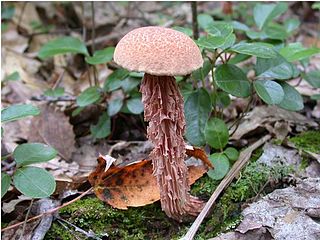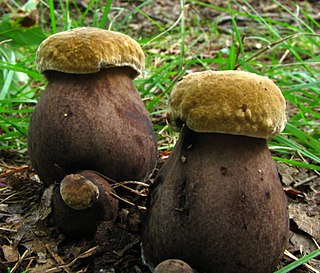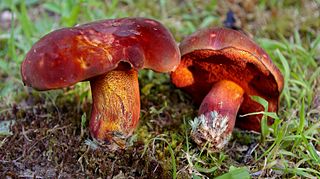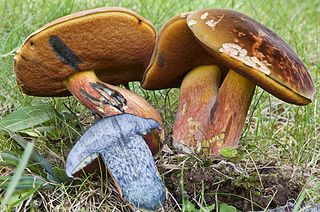
Bothia is a fungal genus in the family Boletaceae. A monotypic genus, it contains the single species Bothia castanella, a bolete mushroom first described scientifically in 1900 from collections made in New Jersey. Found in the eastern United States, Costa Rica, China, and Taiwan, it grows in a mycorrhizal association with oak trees. Its fruit body is chestnut brown, the cap is smooth and dry, and the underside of the cap has radially elongated tubes. The spore deposit is yellow-brown. The edibility of the mushroom is unknown. Historically, its unique combination of morphological features resulted in the transfer of B. castanella to six different Boletaceae genera. Molecular phylogenetic analysis, published in 2007, demonstrated that the species was genetically unique enough to warrant placement in its own genus.

Phylloporus rhodoxanthus, commonly known as the gilled bolete, is a species of fungus in the family Boletaceae. As suggested by its common name, the distinctive feature of this species is its yellow gills—an unusual feature on a bolete mushroom.

Exsudoporus frostii, commonly known as Frost's bolete or the apple bolete, is a bolete fungus first described scientifically in 1874. A member of the family Boletaceae, the mushrooms produced by the fungus have tubes and pores instead of gills on the underside of their caps. Exsudoporus frostii is distributed in the eastern United States from Maine to Georgia, and in the southwest from Arizona extending south to Mexico and Costa Rica. A mycorrhizal species, its fruit bodies are typically found growing near hardwood trees, especially oak.

Xerocomellus zelleri, commonly known as Zeller's bolete, is an edible species of mushroom in the family Boletaceae. First described scientifically by American mycologist William Alphonso Murrill in 1912, the species has been juggled by various authors to several genera, including Boletus, Boletellus, and Xerocomus. Found solely in western North America from British Columbia south to Mexico, the fruit bodies are distinguished by their dark reddish brown to nearly black caps with uneven surfaces, the yellow pores on the underside of the caps, and the red-streaked yellow stems. The fungus grows in summer and autumn on the ground, often in Douglas fir forests or on their margins. The development of the fruit bodies is gymnocarpic, meaning that the hymenium appears and develops to maturity in an exposed state, not enclosed by any protective membrane.

Caloboletus rubripes, commonly known as the red-stipe bolete or the red-stemmed bitter bolete, is a mushroom in the family Boletaceae. It was known as Boletus rubripes until 2014. Fruit bodies (mushrooms) are robust, with caps up to 18 cm in diameter, atop thick stipes 5–12 cm long. Mushrooms are non-toxic, but is so bitter as to be inedible. The mushroom flesh has a very strong bluing reaction when cut or damaged. and forms mycorrhizal relationships, primarily with conifers. It can be differentiated from similar boletes by its cap color and non-reticulate stipe.

Rubroboletus rhodoxanthus is a species of bolete in the family Boletaceae, native to Europe. Previously known as Boletus rhodoxanthus, it was transferred in 2014 to the newly erected genus Rubroboletus, based on DNA data.

Suillus cothurnatus is a species of mushroom in the genus Suillus. Found in Malaysia, Brazil, and North America, it was first described scientifically by mycologist Rolf Singer in 1945.

Aureoboletus russellii, commonly known as Russell's bolete, is a species of bolete fungus in the family Boletaceae. An edible species, it is found in Asia and eastern North America, where it grows in a mycorrhizal association with oak, hemlock, and pine trees. Fruit bodies of the fungus are characterized by their coarsely shaggy stem. The yellow-brown to reddish-brown caps are initially velvety, but become cracked into patches with age.

Tylopilus tabacinus is a species of bolete fungus in the family Boletaceae. It is characterized by a tawny-brown cap measuring up to 17.5 cm (6.9 in) in diameter, and a reticulated stem up to 16.5 cm (6.5 in) long by 6 cm (2.4 in) thick. A characteristic microscopic feature is the distinctive crystalline substance encrusted on the hyphae in the surface of the cap. The species is known from the eastern United States from Florida north to Rhode Island, and west to Mississippi, and from eastern Mexico. It is a mycorrhizal species, and associates with oak and beech trees.

Tylopilus atronicotianus, commonly known as the false black velvet bolete, is a bolete fungus in the family Boletaceae. First described scientifically in 1998, it is known only from the eastern United States.

Boletus rubroflammeus is a species of bolete fungus in the family Boletaceae. First described from Michigan in 1971, it is found in the eastern United States and Mexico, where it grows in a mycorrhizal association with hardwood trees. The fruit bodies (mushrooms) of the fungus have caps that are deep red to purplish red, and dark red pores. The stem has coarse, dark red reticulations and a narrow yellow area at the top. All parts of the mushroom quickly stain blue when injured or cut. Lookalikes include Boletus flammans, a lighter-colored species that grows with conifers. Other similar species can be distinguished by differences in distribution, morphology, staining reaction, and microscopic characteristics. Boletus rubroflammeus mushrooms are poisonous, and can cause gastrointestinal distress if consumed.

Boletus abruptibulbus is a species of bolete mushroom in the family Boletaceae. Described as new to science in 2009, it is found only in the Gulf Coast of the Florida Panhandle, where it grows on the ground in coastal sand dunes, one of only three North American boletes known to favor this habitat. The fruit bodies have convex brownish caps up to 8 cm (3.1 in) in diameter, supported by solid yellowish to reddish stems measuring 3–5 cm (1.2–2.0 in) long by 10–15 mm (0.4–0.6 in) thick. The pores on the underside of the cap measure about 1–2 mm in diameter and are initially pale yellow before developing a greenish tinge in age. The mushroom's spores, about 20 micrometers long, are unusually long for a member of the Boletaceae. The stem base is bulbous, a diagnostic feature for which the species is named.

Leccinum arenicola is a species of bolete mushroom in the family Boletaceae. Described in 1979, the fruit bodies (mushrooms) grow in sand dunes from New Brunswick south to Cape Cod.

Phylloporus arenicola is a species of bolete mushroom in the family Boletaceae. It is found in the Pacific Northwest region of western North America, where it grows in sand dunes in a mycorrhizal association with pine trees. It is one of only three North American Boletaceae species that occur in coastal sand dunes.

Xerocomus illudens is a species of bolete fungus in the family Boletaceae. Described as new to science in 1898, it is found in Asia and North America, where it grows in a mycorrhizal association with oak.

Boletus carminiporus is a species of bolete fungus in the family Boletaceae. Described as new to science in 1998, the species is found in the southern United States where it grows in a mycorrhizal association with various trees in mixed forests.

Boletus miniato-olivaceus is a species of bolete fungus in the family Boletaceae. Described as new to science in 1874, it is found in eastern North America and northeast Mexico.

Boletus subvelutipes, commonly known as the red-mouth bolete, is a bolete fungus in the family Boletaceae. It is found in Asia and North America, where it fruits on the ground in a mycorrhizal association with both deciduous and coniferous trees. Its fruit bodies (mushrooms) have a brown to reddish-brown cap, bright yellow cap flesh, and a stem covered by furfuraceous to punctate ornamentation and dark red hairs at the base. Its flesh instantly stains blue when cut, but slowly fades to white. The fruit bodies are poisonous, and produce symptoms of gastrointestinal distress if consumed.

Pulveroboletus ravenelii, commonly known as Ravenel's bolete or the powdery sulfur bolete, is a species of bolete fungus in the family Boletaceae. Described as new to science in 1853, the widely distributed species is known from Asia, Australia, North America, Central America, and South America. Mycorrhizal with oak, the fungus fruits on the ground singly, scattered, or in groups in woods. Fruit bodies (mushrooms) have convex to flat, yellowish to brownish-red caps up to 10 cm (4 in) in diameter. On the cap underside, the pore surface is bright yellow before turning dingy yellow to grayish brown with age; it stains greenish blue then grayish brown after injury. A cottony and powdery partial veil remains as a ring on the stipe. The mushrooms are edible, and have been used in traditional Chinese medicine and for mushroom dyeing.

Chalciporus pseudorubinellus is a bolete fungus of the family Boletaceae. It is found in North America and Central America.




















